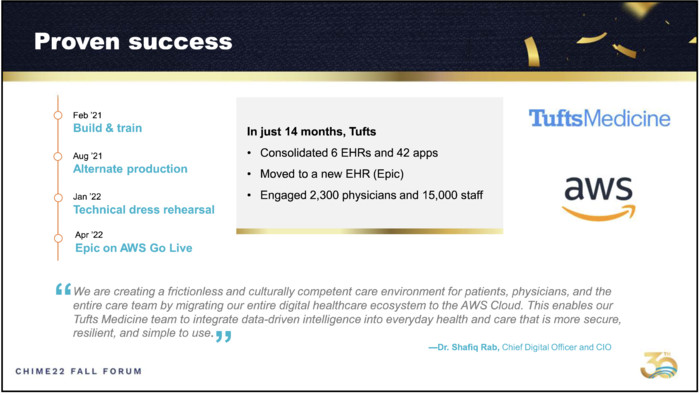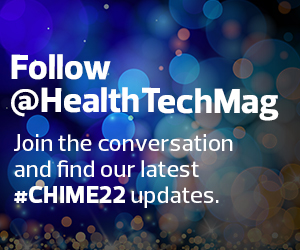Dr. Zafar Chaudry, Chief Digital and Information Officer at Seattle Children’s, stands in front of the audience during his presentation, “Identifying and Addressing Health Equity with Real-World Data.”
Armed with this data, Chaudry said protocols should change to ensure every patient has access to pain medication within a certain time frame, and providers can be monitored to see if they’re compliant.
Being able to collect, record and report on clear measures has helped influence changes to Seattle Children’s strategic objectives and other diversity, equity and inclusion targets. The organization will continue to make changes, Chaudry added.
“You can use your data to effect change,” he said. “It’s been driven by the clinical staff, many of whom didn’t know that they were facing this on a daily basis.”
3. University of Utah Health Boosts Experiences with a Strong Team
University of Utah Health CIO Donna Roach spoke at last year’s CHIME Fall Forum about the academic medical system’s digital health improvements. This year, she returned with her colleagues to talk about the collaboration and processes that helped drive change.
Roach stressed the importance of a cohesive experience across the health system. Digital transformation couldn’t just be contained to the hospitals and clinics, which is why the health system’s Digital Enablement Committee (DEC) also included department chairs, the head of innovation, the head of research, some operational leaders and health sciences members.
The health system’s digital transformation roadmap contained “swim lanes” that addressed specific areas, and the “total experience” was important enough to have its own lane instead of being interwoven into other goals.
“When we think about experience, we don’t just think about patient experience. What I wanted to emphasize is patient, consumer, physician, clinician and employee – it’s total experience,” Roach said. “You can’t do patient experience on the backs of your clinicians, on the backs of your employees. It all has to fit together.”
She emphasized the need for feedback loops to better inform digital strategy. When the health system was testing more online nurse rounding tools through Microsoft Teams and Office 365, nurses were directly involved in the design and process.
Roach chaired the DEC along with Dr. Michael Strong, chief medical information officer, to ensure the digital strategy benefited from a heavy clinical perspective. In his nearly 30 years with the organization, Strong said, as competition arose around the traditional system, the shift to offer an exceptional patient experience has been palpable. But leaders must take charge.
“It has to be a deliberate decision from the top. Culture is never going to change organically. It’s too easy to just continue with the status quo,” he said.
The patient experience officer works with the DEC so that they’re designing programs with patients, not just for them. Senior Director of Digital Transformation Laura Marquez added that continuous learning, whether it garners success or failure, is key.
“As we bring agile into healthcare, which is completely new and unknown to our teammates and colleagues, we recognize that it’s OK to take these risks and create a culture of safety where failing is OK,” she said. “It’s really not failing; it’s learning from those mistakes and trying again.”
Keep this page bookmarked for our coverage of the CHIME22 Fall Forum, which took place Nov. 7-10 in San Antonio. Follow us on Twitter at @HealthTechMag and join the conversation at #CHIME22Fall.















